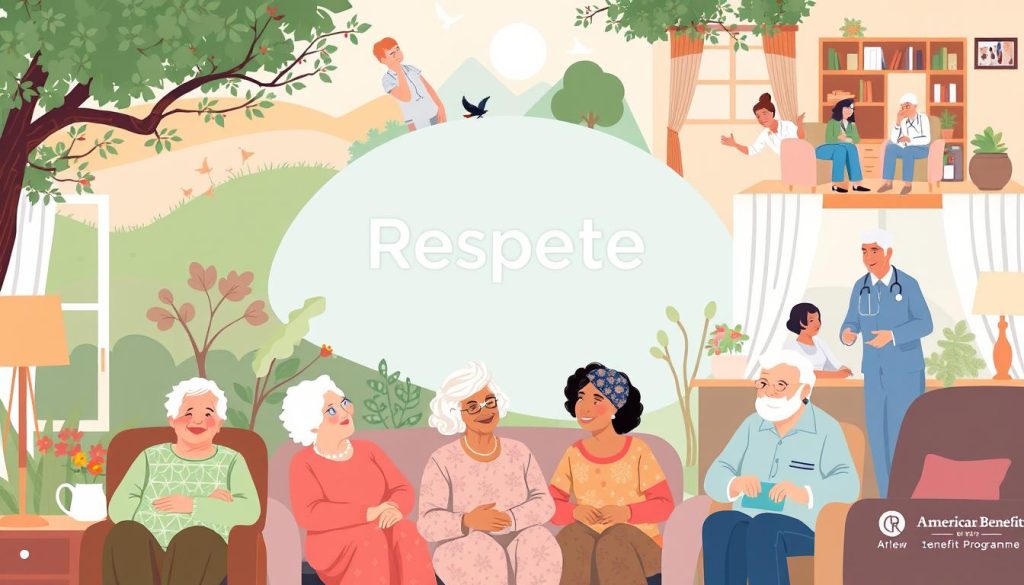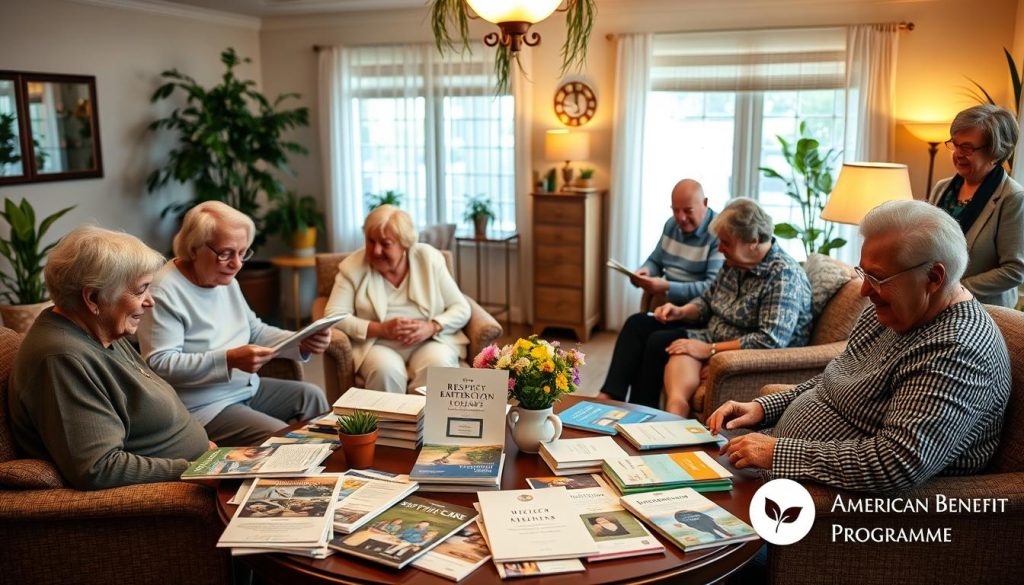Ever thought a break could make you a better caregiver? Respite care is not just nice to have. It’s a must for those who help loved ones with challenges. Caregiving can be hard on your mind and body. So, taking a short break is key. This guide talks about why breaks are vital, the kinds of help you can get, and how to find it. It’s all about bringing back your peace and health.
Key Takeaways
- Respite care can last from a few hours to several weeks, providing necessary breaks for caregivers.
- Medicare generally covers up to five consecutive days of respite care for hospice patients1.
- Adult day care centers offer a supportive environment, typically providing meals and activities during weekdays2.
- Residential programs allow caregivers to receive 24-hour relief during emergency and planned overnight stays2.
- Engaging in peer support can serve as an effective alternative for respite care2.
Understanding Respite Care
Respite care helps family caregivers take care of loved ones with special needs. It lets caregivers have breaks for a few hours or overnight. This helps them manage their stress and tasks3. You can find respite care at home, adult day centers, or special places3.
Adult day centers offer fun, health, and social activities. They help seniors make friends and feel less lonely3. Respite care is necessary for caregivers needing personal time or when extra care is needed3. It prevents caregiver burnout by offering relief3.
Local resources, websites, and doctors can help find respite care3. To get this care, both the caregiver’s and recipient’s needs are considered3.
Knowing what respite care costs is important. In-home care costs about $150 a day. Day services are around $78 a day4. Most insurances don’t cover these costs, but Medicaid might help. Veterans might also get help for respite care4.
Importance of Seeking Caregiver Relief
Being a caregiver feels rewarding but is hard. Twenty percent of U.S. folks, or 53 million, help others. They do tasks like cooking and handling money for those in need in their area5. Family caregivers often spend 24 hours a week for about 4.5 years. This takes a lot of their time and effort5. So, it’s crucial for caregivers to find ways to relax. This helps them stay well in mind and body6.
Planning short breaks helps a lot. Although 85% of caregivers don’t get these breaks due to various reasons, breaks are very good5. They help caregivers feel less worn out. This can keep them healthier6. Breaks also make relationships better. They prevent feeling upset for giving care all the time without a break5. Plus, getting breaks often means fewer hospital visits. And, both the caregiver and the one receiving care feel happier5.
What is Respite Care for Caregivers?
Respite care gives short-term help for family caregivers who need a break. It can come from friends, family, volunteers, or pros. The care lasts a few hours to weeks, fitting many needs. It helps caregivers stay well which is vital for good care.
About 60% of caregivers aged 19 to 64 feel their health is poor. They might have chronic conditions or disabilities7. This shows why respite care is important for them. In the US, Medicaid and Medicare might pay for it, depending on where you live7. Respite care can also save money by reducing nursing home use8.
Caregivers of Veterans can find special tools and tips. PsychArmor offers free courses to make good respite plans9. These resources help caregivers take better care of themselves and others.
Benefits of Respite Care
Respite care is a great help for caregivers. It lets them take a break and recharge. This helps them provide better caregiver relief services. Both the caregiver and the person being cared for benefit from this.
Restoring Energy and Reducing Stress
Respite care lets caregivers rest and get their energy back. It’s great for those feeling worn out. It helps them feel better and less stressed1011. Caregivers can look after their health while still helping others.
Enhancing Quality of Care
Well-rested caregivers give the best care. They can pay more attention to the person’s needs11. This makes their relationship stronger and improves caregiving. Respite care keeps caregivers well, leading to high care standards.
Preventing Caregiver Burnout
Regular breaks prevent long-term stress issues. They help caregivers keep going without feeling guilty1012. Respite care also brings new views and friends for both caregivers and receivers. It boosts their mental health11.

| Benefit | Description |
|---|---|
| Restores Energy | Allows caregivers to recharge, leading to lower stress levels. |
| Improves Care Quality | Well-rested caregivers provide better, more compassionate care. |
| Prevents Burnout | Regular breaks help maintain mental health and prevent burnout. |
| Encourages Social Interaction | Respite care prevents isolation and promotes social engagement. |
Want to learn how respite care can make life better? Check out resources on respite care benefits that could help101112.
Types of Respite Care Options
It’s important to look at different respite care options for caregivers who need a break. Each choice is made for certain needs. This lets caregivers pick what’s best for them. Here are some main respite care types to think about:
In-Home Respite Care Services
Convenience and comfort come with in-home respite care. Trained pros or volunteers help out right at home. Home Instead is an agency that offers this kind of help. They make sure schedules match what families need13.
Adult Day Care Programs
Adult day care centers offer fun activities, food, and time with friends for seniors. These places are often affordable, costing less than $80 a day. Caregivers can take a break, knowing their loved ones are happy and safe14.
Residential Care Facilities
Assisted living or senior communities are types of residential care facilities. They let seniors stay for a short time. Here, they get care all day and night. This includes meals and help with medicine. Choosing the right place is key. It must meet the needs of both caregivers and seniors13.
Choosing the right respite care is good for caregivers and their families. Knowing costs helps with planning. For example, a stay in a residential place costs about $152 a day14.
| Type of Respite Care | Cost (Average) | Features |
|---|---|---|
| In-Home Respite Care Services | $26 per hour | Professional care in a familiar environment |
| Adult Day Care Programs | $80 per day | Structured activities and social opportunities |
| Residential Care Facilities | $152 per day | 24/7 support including meals and medication distribution |
Making the right respite care choice can really help improve life for caregivers and their loved ones1314.
Finding Respite Care Programs Near You
Finding the right respite care programs is key for caregivers who need help. There are many ways to find respite care near me. These help you see local options that fit your needs.
Alabama offers a free online list of respite providers. It is sorted by county and disability type, making it easy to find help15. Arizona has a Caregiver Coalition. It provides a helpline and info about respite vouchers15. California supports caregivers with 11 nonprofit centers. They help families with chronic health issues find care15.
Community groups also guide caregivers to respite services. Colorado has an online finder for state-wide services15. Hawaii’s Caregiver Alliance has a tool. It helps caregivers find support easily15.
It’s important to look at different respite programs. Check their cost, reliability, and what they offer. Planned respite care lets caregivers rest. It also keeps the cared-for person safe and sound16.
Here is a table outlining some essential respite care programs across different states:
| State | Program/Resource | Description |
|---|---|---|
| Alabama | Lifespan Respite Network | Online database of respite providers by county and disability type. |
| Arizona | Caregiver Coalition | Resource helpline and respite voucher program. |
| California | California Caregiver Resource Centers | Services for family caregivers of adults with chronic conditions. |
| Colorado | Respite Coalition | Online finder for respite and resource services. |
| Hawaii | Caregiver Alliance | Family Caregiver Navigator tool for finding respite services. |
| Virginia | Caregiver Solution Center | Resources for caregivers across all ages. |
Cost Considerations for Respite Care Services
Planning how much to spend on respite care is key for caregivers needing a break. Costs of respite care change a lot, depending on where you live and what kind of help you get. Hiring professional care might mean paying by the hour. But getting help from family or volunteers might cost nothing. Prices for getting care at home can range from $20 to $35 per hour. The average daily cost is about $150 for in-home care and care in assisted living places1718.
Understanding Insurance Coverage
It helps caregivers a lot to know if insurance will pay for respite care. Some insurance, like long-term care insurance, might help cover costs. Medicare usually helps with short stays after hospital visits. Medicaid might help too, if you qualify17.
Exploring Financial Assistance Options
There’s help available for caregivers to pay for respite care. Veterans might get monthly payments to help cover costs. Local charities and grants can also offer money to help. These are good to look into. On average, adult day care costs about $78 a day18. Caregivers should check out these options, as they can really help with costs17.
| Type of Respite Care | Hours/Day | Cost Range |
|---|---|---|
| In-Home Respite Care | 1-24 | $20-$35 per hour |
| Adult Day Care | Full Day | $78 per day |
| Assisted Living Facility | Full Day | $150-$176 per day |
Caregiver Support Resources
Getting help is key for anyone taking care of someone else. In the U.S., about 53 million people look after someone with special needs. This shows a big group of caregivers looking for help19. Groups like the Well Spouse Association help a lot. They give info and support. Caregiver relief services are also important. They let caregivers take breaks to stay healthy while helping others.
Joining support groups is a great way for caregivers to talk and share tips. This creates a support circle and reduces feeling alone. 22% of caregivers say they have a hard time staying healthy because of their duties19. In South Carolina, a program helped 3,331 caregivers last year. This shows how crucial local support is19.
There are also ways to get financial help, like what the National Organization for Rare Diseases offers20. This help is for when caregivers really need a break. Knowing about these resources can really help caregivers do their job better. It can make their lives better too.

Planning for Respite Care
It’s very important to plan well for respite care. This helps caregivers take a break to stay healthy. Getting enough break time helps caregivers feel refreshed and handle their duties better21. Caregivers should figure out what they need. Then, they can find the right support programs22.
Adding other caregiver relief services makes the support better. Knowing the care receiver’s daily life and preferences ensures they get good care when the caregiver is away23. In emergencies, nursing homes can offer short stays for respite22.
- Establish a clear schedule for respite to streamline transitions.
- Communicate openly with both the care recipient and the respite provider.
- Utilize tools provided by organizations such as the VA for advanced respite planning.
Creating a thorough respite care plan is key22. It should have medical info and fun activities. And, it must have emergency plans and guidance for backup caregivers22. Good planning helps caregivers and eases stress for the family. This makes for happier caregiving21.
| Service Type | Details | Benefits |
|---|---|---|
| In-Home Care | Care provided at the family’s home | Familiar environment for the care recipient |
| Community Programs | Local organizations offering respite services | Enhanced support and social interaction |
| Long-Term Facilities | Short-term stays in nursing homes | Professional care and supervision during emergency situations |
By planning ahead for respite care, caregivers can get needed breaks. They can make sure their loved ones are still cared for21.
Good planning also creates a better setting for everyone involved.
Overcoming Barriers to Seeking Help
Many caregivers struggle to accept help. They worry about quality and feel guilty. Knowing that overcoming these barriers leads to better health is key. Respite care benefits include less stress and more wellness. Caregivers should learn about the National Family Caregivers Support Program. It provides funds for respite advice and help. This can encourage caregivers to look after their health24.
Talking with friends or joining support groups helps. These actions create a more positive view of taking breaks. The National Volunteer Caregiving Network offers non-medical help to caregivers. This reduces their load24. Breaks are essential, not just a nice to have. They can lessen loneliness, lower anxiety, and reduce caregiver stress. This also makes family life better25.
Oregon and Wisconsin show how respite care programs can work well. These examples prove communities can overcome barriers. Seeing respite care as necessary helps caregivers feel more energized. For more on overcoming these barriers, check out the National Respite Coalition. They push for better access to these vital services24.
Engaging Family and Friends in Caregiving
Family and friends are key in caregiving. They help lighten the load for main caregivers. Talking about needs and how to help builds a strong support network.
Using a shared calendar helps organize caregiving tasks. It lets everyone know their part which eases the caregiver’s burden. This helps the caregiver get some needed personal break time.
About 48 million people in the U.S. care for someone else26. Family caregivers give around $600 billion in unpaid help each year26. Many caregivers also struggle with their own mental health. About 45% say they need mental health support27. Even with these challenges, 61% of caregivers work while caregiving26. Getting help from loved ones can make a big difference.
Learning about support for caregivers is helpful. It teaches family how to be a part of caregiving. This teamwork makes everyone feel less alone and stressed. It also brings families closer together.
When family and friends help, caregiving gets easier. This group effort makes caregiving a shared job. It creates a better situation for everyone involved28.
Conclusion
Respite care is key for keeping caregivers and the quality of care high. Studies show many families don’t use the help they can get; about 29% of eligible families didn’t try29. If caregivers understand how respite care helps, they can avoid burnout and recover.
Many families like having respite care at home29. This makes getting support better. Finding the right help reduces stress and makes life better. Making a plan for respite care helps caregivers and their loved ones greatly.
Source Links
- What Is Respite Care?
- Respite Care for Caregivers: What it is and Where to Find it
- Things You Need to Know: What Is Respite Care and Its Advantage | Decent
- Respite Care: How to Find It, Pay for It, and More
- Caregiver Respite: An Essential Component of Home & Community-Based Long-Term Care
- The Vital Role of Respite Care for Caregivers: Nurturing the Soul While Caring for Others
- Respite care
- Respite
- VA.gov | Veterans Affairs
- 5 Benefits of Respite Care
- The benefits of respite care for family caregivers
- Is Respite Care Right for Our Family?
- The Different Types of Respite Care
- Respite Care
- Find a Respite Provider | ARCH National Respite Network & Resource Center
- Respite Care
- Who pays for respite care? What you need to know
- The Average Cost Of Respite Care
- Family Caregiver Support | South Carolina Department on Aging
- How to Pay for Respite | ARCH National Respite Network & Resource Center
- Planning for Respite | ARCH National Respite Network & Resource Center
- Respite Care Workbook : Strategies/Guide for Caregivers : Caregivers : HD Reach
- Create a Respite Care Plan to Give Caregivers a Break
- A Comprehensive Guide to Respite Care for Caregivers
- Barriers and enablers in the use of respite interventions by caregivers of people with dementia: an integrative review
- Respite Services: A Critical Support for Family Caregivers – AARP LTSS Choices Spotlight
- Identifying and Engaging Family Caregivers
- What Is Respite Care for Caregivers?
- Respite care: Lessons from a controlled design study

Leave a Reply